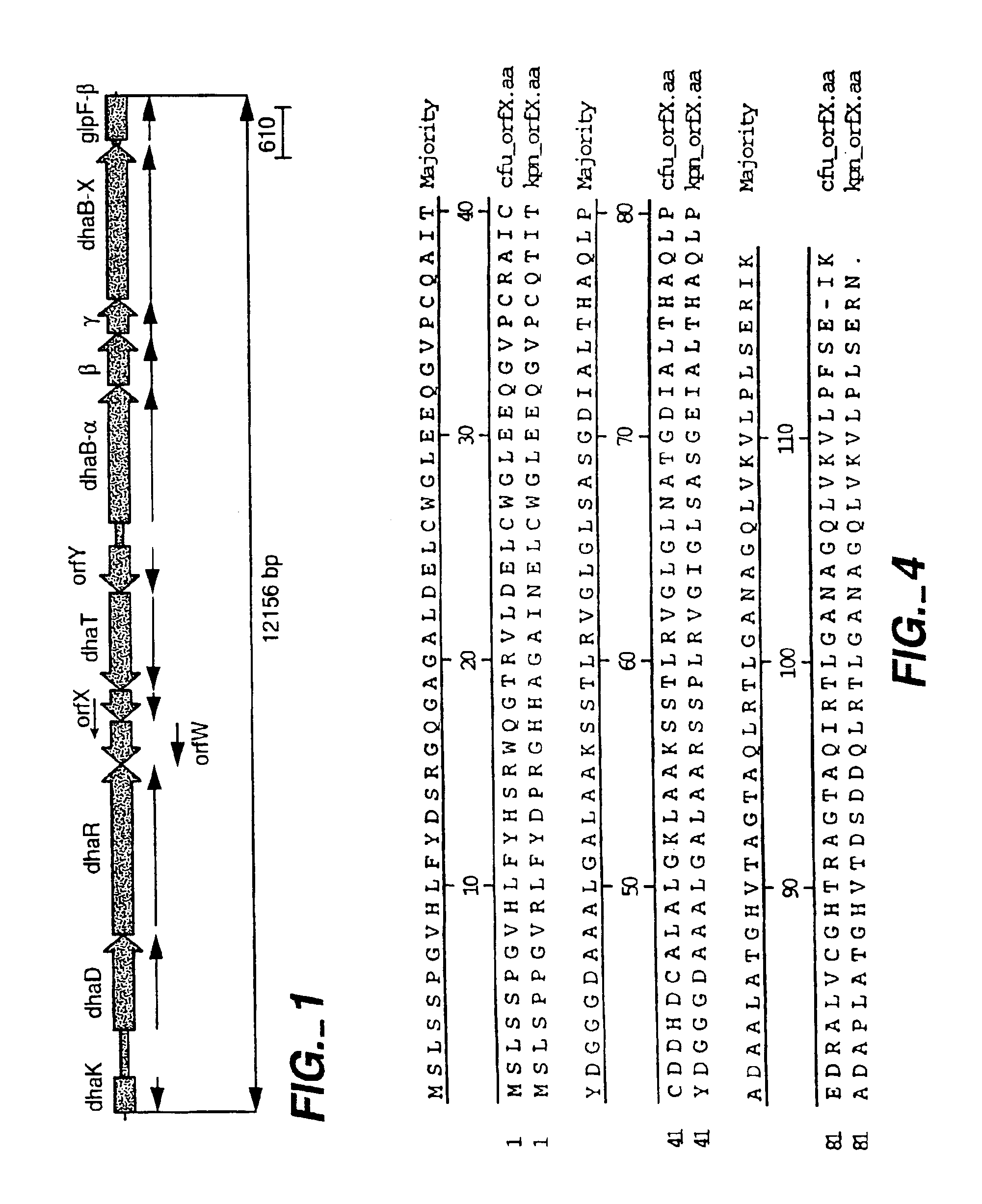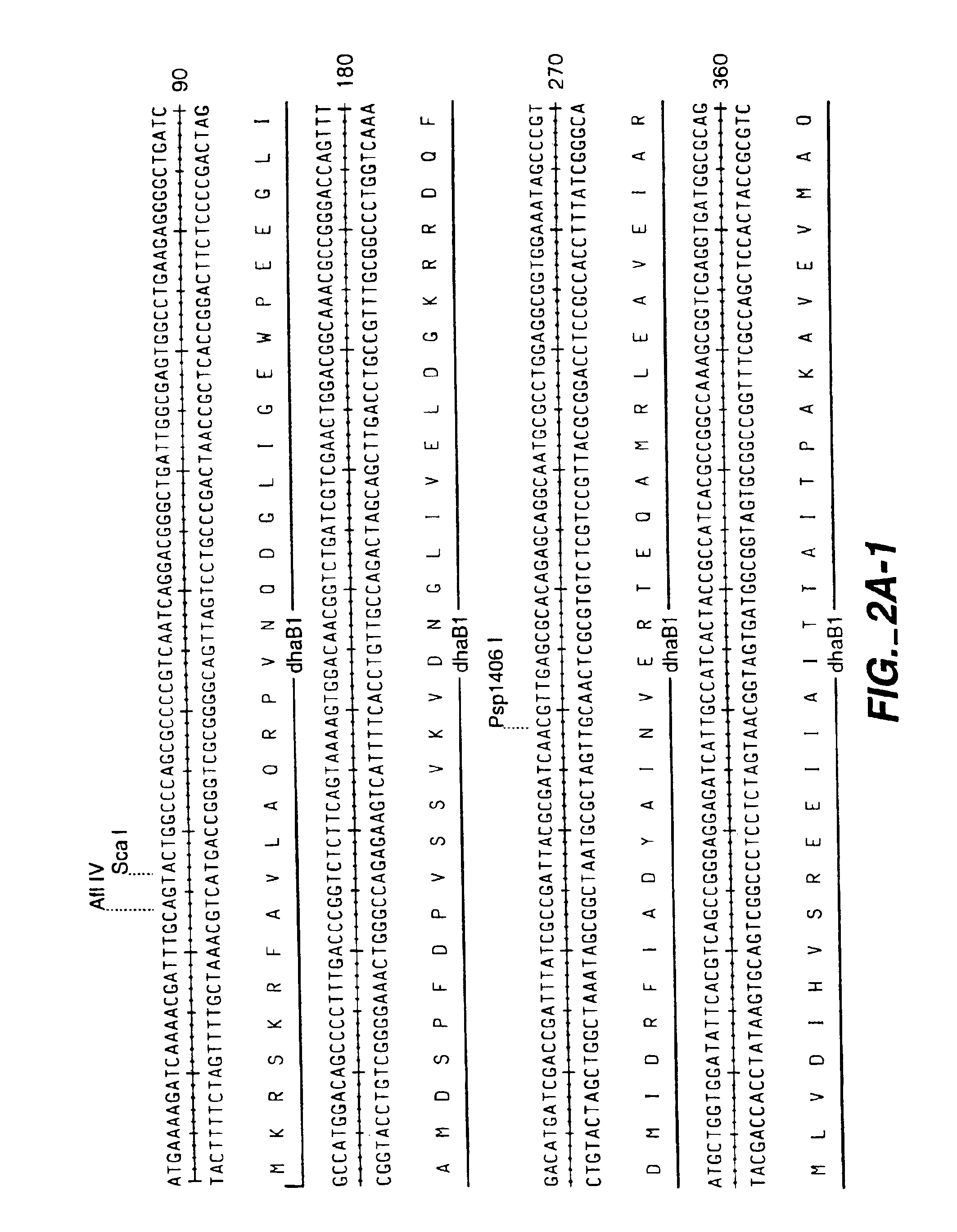Method for the recombinant production of 1,3-propanediol
a technology of 1,3-propanediol and recombinant organisms, which is applied in the field of molecular biology, can solve the problems of limited methods, waste streams containing environmental pollutants, and never been demonstrated that the entire process can be accomplished by a single recombinant organism, and achieve the effect of increasing the production of 1,3-propanediol
- Summary
- Abstract
- Description
- Claims
- Application Information
AI Technical Summary
Benefits of technology
Problems solved by technology
Method used
Image
Examples
example 1
Cloning and Transformation of E. Coli Host Cells with Cosmid DNA for the Production of 1,3-Propanediol
Media
[0143]Synthetic S12 medium was used in the screening of bacterial transformants for the ability to make 1,3-propanediol. S12 medium contains: 10 mM ammonium sulfate, 50 mM potassium phosphate buffer, pH 7.0, 2 mM MgCl2, 0.7 mM CaCl2, 50 uM MnCl2, 1 uM FeCl3, 1 uM ZnCl, 1.7 uM CuSO4, 2.5 uM CoCl2, 2.4 uM Na2MoO4, and 2 uM thiamine hydrochloride.
[0144]Medium A used for growth and fermentation consisted of: 10 mM ammonium sulfate; 50 mM MOPS / KOH buffer, pH 7.5; 5 mM potassium phosphate buffer, pH 7.5; 2 mM MgCl2; 0.7 mM CaCl2; 50 uM MnCl2; 1 uM FeCl3; 1 uM ZnCl; 1.72 uM CuSO4; 2.53 uM COCl2; 2.42 uM Na2MoO4; 2 uM thiamine hydrochloride; 0.01% yeast extract; 0.01% casamino acids; 0.8 ug / mL vitamin B12; and 50 ug / mL amp. Medium A was supplemented with either 0.2% glycerol or 0.2% glycerol plus 0.2% D-glucose as required.
Cells:
[0145]Klebsiella pneumoniae ECL2106 (Ruch et al., J. Bact...
example 2
Conversion of D-Glucose to 1,3-Propanediol by Recombinant E. coli Using DAR1, GPP2, dhaB, and dhaT
Construction of General Purpose Expression Plasmids for Use in Transformation of Escherichia coli
The Expression Vector pTacIQ
[0160]The E. coli expression vector, pTacIQ, contains the lacIq gene (Farabaugh, Nature 274, 5673 (1978)) and tac promoter (Amann et al., Gene 25, 167 (1983)) inserted into the EcoRI of pBR322 (Sutcliffe et al., Cold Spring Harb. Symp. Quant. Biol. 43, 77 (1979)). A multiple cloning site and terminator sequence (SEQ ID NO:20) replaces the pBR322 sequence from EcoRI to SphI.
Subcloning the Glycerol Dehydratase Genes (dhaB1,2,3)
[0161]The open reading frame for dhaB3 gene (incorporating an EcoRI site at the 5′ end and a XbaI site at the 3′ end) was amplified from pHK28-26 by PCR using primers (SEQ ID NOS:21 and 22). The product was subcloned into pLitmus29 (New England Biolab, Inc., Beverly, Mass.) to generate the plasmid pDHAB3 containing dhaB3.
[0162]The region cont...
example 3
Cloning and Expression of dhaB and dhaT in Saccharomyces cerevisiae
[0178]Expression plasmids that could exist as replicating episomal elements were constructed for each of the four dha genes. For all expression plasmids a yeast ADH 1 promoter was present and separated from a yeast ADH1 transcription terminator by fragments of DNA containing recognition sites for one or more restriction endonucleases. Each expression plasmid also contained the gene for b-lactamase for selection in E. coli on media containing ampicillin, an origin of replication for plasmid maintenance in E. coli, and a 2 micron origin of replication for maintenance in S. cerevisiae. The selectable nutritional markers used for yeast and present on the expression plasmids were one of the following: HIS3 gene encoding imidazoleglycerolphosphate dehydratase, URA3 gene encoding orotidine 5′-phosphate decarboxylase, TRP1 gene encoding N-(5′-phosphoribosyl)-anthranilate isomerase, and LEU2 encoding b-isopropylmalate dehydr...
PUM
| Property | Measurement | Unit |
|---|---|---|
| pH | aaaaa | aaaaa |
| pH | aaaaa | aaaaa |
| pH | aaaaa | aaaaa |
Abstract
Description
Claims
Application Information
 Login to View More
Login to View More - R&D
- Intellectual Property
- Life Sciences
- Materials
- Tech Scout
- Unparalleled Data Quality
- Higher Quality Content
- 60% Fewer Hallucinations
Browse by: Latest US Patents, China's latest patents, Technical Efficacy Thesaurus, Application Domain, Technology Topic, Popular Technical Reports.
© 2025 PatSnap. All rights reserved.Legal|Privacy policy|Modern Slavery Act Transparency Statement|Sitemap|About US| Contact US: help@patsnap.com



